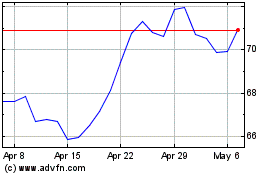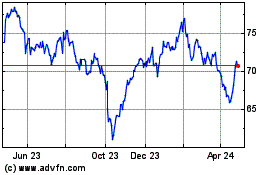By Annie Gasparro and Saabira Chaudhuri
Gum makers are mixing everything from vitamins to candy into
their recipes to give customers more incentives to pick up a
pack.
Chewing gum has lost sales to mints, and customers have
gravitated to other means of burning nervous energy, like fidget
spinners and smartphones, executives and market-research firms say.
Some people say they dropped gum-chewing because it seems tacky or
causes jaw pain. Gum sales dropped 4% globally by volume between
2010 and 2018, according to Euromonitor, and 23% in the U.S.
"Chewing gum is becoming less socially acceptable," said Dirk
Van de Put, chief executive of Mondelez International Inc., owner
of Trident and Dentyne, in a recent interview.
Trying to turn things around, Mondelez and other gum makers are
coming up with formulas that they say convey additional benefits.
Trouble sleeping? There is a gum for that. Other new chewing gums
purport to boost energy, alleviate headaches and stimulate weight
loss.
"The consumer these days is becoming much more interested in the
functional benefits of food," Mr. Van de Put said. "Gum is an
interesting carrier of benefits."
He suggested the possibility of a gum designed to boost energy
and another containing cannabidiol, a compound derived from hemp
that many consumers and food makers believe conveys health
benefits. The maker of Oreo cookies and Ritz crackers has added a
gum under its Halls brand in Europe, moving the cough-drop brand
into breath-freshening. Separately, it is looking for ways to
promote the gum's benefits, like oral care, in the U.S.
Mondelez, Mars Inc., Hershey Co. and Perfetti Van Melle Group
B.V. dominate global gum sales. But some of these companies are
losing market share, as smaller brands introduce gums meant for
more than chewing.
Apollo Brands LLC is selling "Fly Gum," which releases caffeine
and vitamin B. The Denver startup said its gum helps frequent
travelers and pilots combat jet lag. Apollo also sells the same
recipe as "Golf Gum" that purports to help golfers stay energetic
and focused. Los Angeles-based NeuroGum makes a caffeine-laden
brand that touts the same benefits.
Snack Less makes a gum containing an extract from Hoodia
parviflora, a plant that many wellness experts and consumers
believe suppresses hunger, although medical professionals have
rebuffed that claim. Simply Gum LLC says its all-natural
ingredients offer a healthier, biodegradable alternative to the
synthetic rubber used in most gum.
Sales for gum with such added benefits are small but growing
faster than gum sales overall, according to market-research firm
Mintel. Its survey showed that consumers are interested in gum
fortified with vitamins, designed to ease digestion and other
benefits.
Functional products have become more popular as people look for
more natural ways to address health concerns, low energy or
insomnia. Successful brands can command a premium for products that
purport to have such added benefits. That has helped gum sales rise
1.3% in dollar terms this year, according to market-research firm
Nielsen, even though volumes are down 7% in the U.S.
The Food and Drug Administration reviews safety reports that
companies submit for new additives but doesn't weigh in on whether
the benefits touted are delivered in full.
Gum manufacturers say chewing gum is efficient in conveying
supplements like caffeine or cannabidiol because they can be
quickly absorbed into the bloodstream rather than taking 30 minutes
as with most swallowable pills.
Some customers say they aren't swayed by the added benefits of
new gums. Jim Paquette, an entertainer on a Norwegian cruise ship,
has started buying mints rather than gum to freshen his breath.
"Sometimes you have to sit around chewing gum for half an hour
because--what are you going to do with it?" he said.
Medicated chewing gum has been around since the 1920s when
inventor Frank Dillard introduced Aspergum, laced with aspirin.
RetroBrands U.S.A. LLC bought the trademark for Aspergum and is
working to get it back in stores.
"The gum category has been on a downward spiral for many years.
Functional gum may help," said RetroBrands President Jeff Kaplan,
who is also seeking ownership of the discontinued Chiclets
brand.
Some recent attempts at multipurpose gum have sputtered.
Wrigley, around since the 19th century and now owned by Mars,
introduced Alert Energy Caffeine Gum in 2013. It was quickly pulled
over concerns that its 40 milligrams of caffeine per stick would
encourage too much caffeine for children.
Mars brought it back in 2017 with clearer labeling of the high
caffeine content. Sales were lackluster. Now Alert Caffeine Gum is
no longer in mass distribution.
Hershey discontinued Ice Breakers Cool Blasts, a gum launched in
2015 that dissolves after a few minutes of chewing, because of weak
sales. Chuck Raup, Hershey's vice president of confection, said the
company has since focused on marketing its existing gum brands
rather than coming up with new products that promise to be more
than chewy.
But other companies are still working to woo customers by
melding gum and candy.
Wacker Chemie AG, an ingredients supplier to gum makers, has
developed a cooking process that allows manufacturers to infuse gum
with chewy candy and natural ingredients, such as fruit juice and
cocoa.
And Perfetti Van Melle two years ago began selling gum
containing tiny bits of Airheads candy. The Italian confectioner
hopes the cherry, watermelon and blue-raspberry flavored gums will
appeal to younger candy fans, said Jan Heeling, its chief marketing
officer.
"We don't educate children anymore to start coming into the gum
category and chewing our gum," Mr. Heeling said.
Write to Annie Gasparro at annie.gasparro@wsj.com and Saabira
Chaudhuri at saabira.chaudhuri@wsj.com
(END) Dow Jones Newswires
December 03, 2019 05:44 ET (10:44 GMT)
Copyright (c) 2019 Dow Jones & Company, Inc.
Mondelez (NASDAQ:MDLZ)
Historical Stock Chart
From Dec 2024 to Jan 2025

Mondelez (NASDAQ:MDLZ)
Historical Stock Chart
From Jan 2024 to Jan 2025
